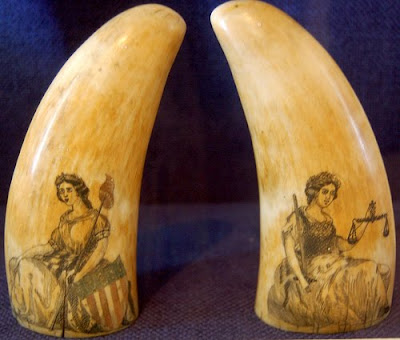CXXVI SCRIMSHAW KNIFE: AUTHENTIC BONE CARVING FROM MAINE


 CXXVI - Scrimshaw Knife
CXXVI - Scrimshaw KnifeDETAILS: Two blade pocket knife hand etched in a small workshop in Maine. The scrimshaw is inked with black india ink and sealed with 2 coats of archival wax to protect the intricate design and to enhance its beautiful finish. The knife handle is bone (not ivory) and measures 4 1/8" folded.
$95
shop
Scrimshaw is derived from the practice of sailors on whaling ships creating common tools, where the byproducts of whales were readily available. The term originally referred to the making of these tools, only later referring to works of art created by whalers in their spare time. Whale bone was ideally suited for the task, as it was easy to work and was plentiful.
The development of scrimshaw took off after the market for whale teeth, which was sought by Chinese traders for use in the Pacific Islands (for example the Fijian market for tabua), was flooded with teeth after a narrative by an American sailor, Captain David Porter, revealed both the market and the source of the teeth. Around this time is the earliest authenticated pictorial piece of scrimshaw (1817). The tooth was inscribed with the following: "This is the tooth of a sperm whale that was caught near the Galapagos islands by the crew of the ship Adam [of London], and made 100 barrels of oil in the year 1817."
Other sea animal ivories were also used as alternatives for rarer whale teeth. Walrus tusks, for example, may have been acquired in trade from indigenous walrus hunters.
Scrimshaw essentially was a leisure activity for whalers. Because the work of whaling was very dangerous at the best of times, whalers were unable to work at night. This gave them a great deal more free time than other sailors. A lot of scrimshaw was never signed and a great many of the pieces are anonymous. Early scrimshaw was done with crude sailing needles, and the movement of the ship, as well as the skill of the artist, produced drawings of varying levels of detail and artistry. Originally, candle black, soot or tobacco juice would have been used to bring the etched design into view. Today's artists use finer tools in various sizes, mostly borrowed from the dental industry. Some scrimshanders ink their work with more than one color, and restrained polychromed examples of this art are now popular as well.
 A killed and captured sperm whale, the preferred source of whale teeth and bones used in scrimshaw, 1902.
A killed and captured sperm whale, the preferred source of whale teeth and bones used in scrimshaw, 1902.
The development of scrimshaw took off after the market for whale teeth, which was sought by Chinese traders for use in the Pacific Islands (for example the Fijian market for tabua), was flooded with teeth after a narrative by an American sailor, Captain David Porter, revealed both the market and the source of the teeth. Around this time is the earliest authenticated pictorial piece of scrimshaw (1817). The tooth was inscribed with the following: "This is the tooth of a sperm whale that was caught near the Galapagos islands by the crew of the ship Adam [of London], and made 100 barrels of oil in the year 1817."
Other sea animal ivories were also used as alternatives for rarer whale teeth. Walrus tusks, for example, may have been acquired in trade from indigenous walrus hunters.
Scrimshaw essentially was a leisure activity for whalers. Because the work of whaling was very dangerous at the best of times, whalers were unable to work at night. This gave them a great deal more free time than other sailors. A lot of scrimshaw was never signed and a great many of the pieces are anonymous. Early scrimshaw was done with crude sailing needles, and the movement of the ship, as well as the skill of the artist, produced drawings of varying levels of detail and artistry. Originally, candle black, soot or tobacco juice would have been used to bring the etched design into view. Today's artists use finer tools in various sizes, mostly borrowed from the dental industry. Some scrimshanders ink their work with more than one color, and restrained polychromed examples of this art are now popular as well.
 A killed and captured sperm whale, the preferred source of whale teeth and bones used in scrimshaw, 1902.
A killed and captured sperm whale, the preferred source of whale teeth and bones used in scrimshaw, 1902.Editor's Note: While we find scrimshaw's story intriguing and its works of art beautiful, all of us at Blackbird agree that whaling is messed up and killing an animal for its ivory is disgusting and illegal (rightly so). We're pleased to inform you that the artisans who've created CXXVI's Scrimshaw Knife source the bone (non-ivory) used in this product by legal, cruelty free means.


